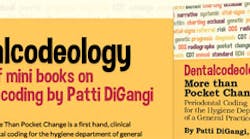Dental hygienists are an integral part of the insurance coding team
by Patti DiGangi, RDH, BS
Electronic health records (EHR) offer a myriad of potential benefits by sharing a patients’ clinical information. Dentistry will need to move to a diagnostic-centered care model to be interoperable with the rest of health care. Coding is at the forefront of this process. Clinical professionals can no longer be hands-off with coding concerns; coding is a team process.
- Consider reading:
- You can do it! Oral sleep apnea therapy coded correctly
- Team EHR: EHR and the office manager – the chart stops here
- Coach's Corner for Dental Coding: Focusing on the new CDT codes for CBCT
Clinicians’ Role
Clinicians need to understand their role in coding. Making and recording a diagnosis is part of CDT coding, an often ignored part. For proper CDT coding, finding the correct code includes looking at:
- General description for category
- Code name (nomenclature)
- Code specific description
All parts are needed for accuracy.
A pertinent example is the section used day-in and day-out in every dental practice, the Clinical Oral Evaluation codes. These are often referred to as the exam codes but that is misleading. There are no exam codes, only oral evaluation codes. The difference is in the section description stating ‘...which includes diagnosis and treatment planning…’ What is most often missing and can only be provided by the clinical professionals is this written diagnosis.
Periodontal disease documentation often lacks diagnostic information. Simplistic thinking that everything is either gingivitis or periodontitis has led to as much as 50% under-diagnosis per the Centers for Disease Control and Prevention. The American Academy of Periodontology (AAP) developed the Classification System for Periodontal Diseases and Conditions in 1999 to give clinicians a way to categorize and diagnose periodontal diseases. This AAP system divides gingival diseases are divided into two categories: plaque-induced and nonplaque-induced both with numerous subcategories. Periodontal diseases are divided into seven categories and again, with numerous subcategories.
Common practice in most offices is to record case types like:
- Type I Gingival disease
- Type II Mild periodontal disease
- Type III Moderate periodontal disease
- Type IV Advanced periodontal disease
These are not disease diagnosis classifications. These are treatment types based on dentistry’s treatment-centered model.
This discussion and more area in Dentalcodeology: More Than Pocket Change. This guide is the first in a series of small books meant to provide simple answers to our day-to-day dilemmas with coding. Can D4341/2 and D1110 be used on the same day? The insurance carrier said to alternate D1110 and D4910. Is this correct? Why are there no codes for care for active gingival disease without bone loss? What the code for periodontal charting?
It is time for dental hygienists to have those answers and more when and where we need them-in our pocket as a mini-book or on our cell as an eBook. Case-based learning can assist you in applying the information. We meet Dominic, Kelly, Nancy, Albert and Wu who are very much like patients we see every day.
Patti DiGangi will have the book for sale in the exhibit hall at UOR this year or ordered at www.dentalcodeology.com.
Patti DiGangi, RDH, BS, is a vision-driven person finding strength and direction from her inner convictions. Like most true visionaries, she views obstacles as learning experiences that can be used for self-development. As a lifelong learner, her energetic, thought-provoking, and successful program development and mind-bending view of what can be shine a bright light for others to preview the future and find their place in it. She can be contacted through her Web site at www.pdigangi.com.






